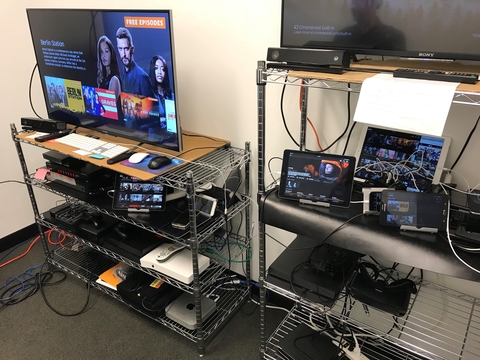Epix is young compared to its premium network competitors like HBO and Showtime. The network launched in 2009, and that youthful scrappiness shows in its dogged pursuit of a better user experience.
The entirety of Epix’s fairly small digital team inhabits about one-half of the 32nd floor of 1540 Broadway, a tower just off Times Square which also houses Viacom. Now that MGM fully owns Epix after buying out Lionsgate and Viacom, the company is moving to a different building in Manhattan. But for now, this is where Epix keeps its “scrum room.”
The scrum room is set like a gadget lover’s dream living room, with minimal furniture and countless game consoles, streaming devices, set-top boxes and virtual reality rigs surrounding one huge television. But the most noticeable feature of the room is the hundreds of brightly colored Post-it Notes plastered to the wall.
Jon Dakss, chief digital officer, said the notes are part of a process called Agile Product Development. Each note represents a ticket for features or fixes to Epix’s various digital platforms, which begin as minimal viable products and then quickly morph through the Agile Product Development process that helps rapidly push out updates. Through daily planning meetings and near-constant tweaks to the apps, Epix is able to iterate faster and come up with features like Epix Cast, which uses technology by a startup called Vizbee.

Epix Cast, which launched earlier this year, allows users to “cast” content from Epix’s Android or iOS apps by automatically finding nearby connected devices including smart TVs and streaming boxes and sending the content to them. Once the content is handed off to a connected device, the user can continue using their smartphone for other things, or even close the Epix app if they want.
“We want to make sure we’re building the products that our users of today love and also that future users love. Our goal is to have the absolute best video experience possible,” Dakss said.
The team
Epix’s digital team isn’t exactly crammed together in its office, but the layout is cozy.
In one small office, the four-person editorial team—led by Melissa Klein, director of editorial and digital production—is huddled together brainstorming metadata tags for movies and series on Epix. The team starts with a title in the center, branches off key topics like time and objects from that, and then further expands those topics into massive bubble diagrams with hundreds of keywords. At the same, the editorial team is hand-curating lists based on upcoming titles, holidays, moods, feelings, etc., which will then be added to the app.
Next door, Miguel Blanco, digital creative director, is reviewing images he created in various sizes and aspect ratios that will be used for Epix titles across all of the company’s platforms. Blanco said that each title gets about 11 images to accommodate different devices and connections, and that Epix tries its best to avoid using just movie posters.
Just down the hall, Neil Davies, vice president of technical operations, is monitoring Epix web and app performance using open-source software like Ansible that allows for full stacks to be spun up quickly for testing new features within the product, and Jenkins for pushing new code to the platforms. Davies said that since Epix moved a lot of its infrastructure to the cloud, it’s able to quickly scale up to handle massive viewership spikes, the kind he said Epix had to deal with once when Katy Perry tweeted something about an Epix show to her millions of followers.
On the other side of Davies' wall sits Sacha Stanton, vice president of technology and chief architect. Stanton is using Mixpanel analytics software to follow some of the huge amounts of data being pulled in through usage on Epix’s platforms. He said Epix stores and tracks every step each user takes on the platform and then turns it around so Epix can use it to optimize the user experience.
Across the hall, Ben Van Wagner, lead front-end developer, shows off the user interface framework that Epix rebuilt using React, a component-based JavaScript library. He said that it’s allowed Epix to have a single code base, to deploy rapid bug fixes, and to see more cross-platform optimization.
This “lean” digital team, as Dakss describes it, has helped make Epix one of the more nimble players in the online video market. Dakss said that Epix started as an on-demand library before it launched on linear and that it was the first TV Everywhere app on Android, Roku, Xbox and web browsers. He said the company was also the first network to roll out offline viewing.
Dakss said that Epix doesn’t currently license any of its tech, like Epix Cast, but he hypothesizes that the Epix platform could be used to launch new services at some point.
For now, though, the Epix team seems wholly focused on maintaining its first-mover status, particularly as it relates to thinking up and delivering new features and functions designed to enhance the user experience.